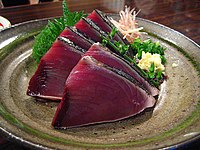Skipjack tuna
| Skipjack tuna | |
|---|---|
 | |
| Conservation status | |
| Scientific classification | |
| Kingdom: | Animalia |
| Phylum: | Chordata |
| Class: | Actinopterygii |
| Order: | Perciformes |
| Family: | Scombridae |
| Tribe: | Thunnini |
| Genus: | Katsuwonus Kishinouye, 1915 |
| Species: | K. pelamis |
| Binomial name | |
| Katsuwonus pelamis (Linnaeus, 1758) | |
Description
Skipjack tuna is a batch spawner. Spawning occurs year-round in equatorial waters, but it gets more and more seasonal further away from the equator. Fork length at first spawning is about 45 centimetres (18 in).[2]
[edit] Fisheries
It is an important commercial and game fish, usually caught using purse seine nets, and is sold fresh, frozen, canned, dried, salted, and smoked. With reported landings of almost 2.6 mill. tonnes, it was world's 2nd most important capture fish species in 2009.[3] Countries recording large amounts of skipjack catches include the Maldives, France, Spain, Malaysia, Sri Lanka, and Indonesia.[4]Skipjack is the most fecund of the main commercial tunas, and its population is considered sustainable against its current consumption.[5][6] Its fishing is still controversial due to the methodology; with rod and reel or fishery options being promoted as ecologically preferable.[7][8][9]
Skipjack is considered to have "moderate" mercury contamination. As a result, pregnant women are advised against eating large quantities.[10][11][12]
Gastronomy
In Japanese cuisine, skipjack tuna is known as katsuo, and is commonly smoked and dried to make katsuobushi, the central ingredient in making dashi (fish stock). Skipjack tuna is also used in katsuo no shiokara. In Indonesian cuisine, skipjack tuna is known as cakalang. Most popular dish from skipjack tuna is cakalang fufu from Minahasa. It is a cured and smoked skipjack tuna clipped on a bamboo frame.[13] Skipjack is also integral to Maldivian cuisine.[14]





No comments:
Post a Comment